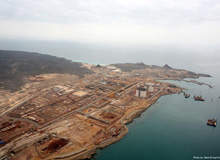
The Yemen liquid natural gas (YLNG) project is in Balhaf, on the coast of Shabwah, about 400km east of Aden.
Launched in August 2005, the project is being developed by a consortium led by France’s Total (39.62% shareholding) with US company Hunt Oil (17.22%), Yemen Gas Company (6.73%), South Korea’s SK Corp (9.55%), Kogas (6%), Hyundai Corporation (5.88%), and the General Authority for Social Security & Pensions of Yemen (5%).
The project, reported to cost about $5bn, has been financed in part with $3bn in debt raised from a syndicate of banks including Bank of Tokyo-Mitsubishi UFJ, Citigroup, ING Group, Royal Bank of Scotland, Société Générale, and Sumitomo Mitsui Banking Corporation.
Reserves dedicated to the project, which lie in the Marib-Jawf gas fields northeast of Sanaa, include 9.15Tcf of proven reserves with 1Tcf allocated for use in the domestic market, and 0.7Tcf of probable reserves. Associated gas is currently produced with oil from about 450 active wells, and a high percentage of the reserves will be produced from fields already in production.
The associated gas is treated to remove the condensate, and extract propane and butane. The resultant lean gas is currently re-injected into the reservoirs to boost oil recovery and production. The objective of the YLNG project is to recover this lean gas, and liquefy and export it.
The project includes new and existing upstream gas processing facilities, including a 25km, 20in transfer line linking two gas processing units in Marib-Jawf, a new spur line to transport domestic gas to the country’s central Ma’bar region and a 320km, 38in main pipeline connecting the processing units to the LNG plant in Balhaf.
The plant consists of two LNG trains that will use the APCI C3/MCR process with a total capacity of 6.7Mtpa. In addition, two 140,000m3 storage tanks are being built, as well as ancillary facilities such as power generation, desalination, waste-water treatment and steam generation, to enable the project to operate on a self-supporting basis.
The port facilities, which became operational in March 2007, will be able to accommodate the loading of vessels with capacities ranging from 70,000m3 to 205,000m3.
In October 2007, YLNG and the Yemen state-owned oil and gas company Safer Exploration and Production agreed a 20-year deal for Safer to supply the plant with up to 12.5bcm of gas per annum from Marib-Jawf. YLNG has sale and purchase agreements to supply France’s GDF Suez (2.5Mtpa) and Total (2Mtpa), and Korea’s Kogas (2Mtpa), running from 2009 to 2029.
The contractors building the LNG trains are a joint venture between France’s Technip, JGC of Japan and US company Kellogg Brown & Root. It’s a turnkey contract led by Technip, and is reported to be worth more than $2bn.
The contract to build the pipeline from Marib-Jawf to the LNG plant, awarded on an EPC basis and with an estimated value of $210m, was given to a joint venture between Amec Spie Capag of France and Yemeni company Hawk International. By the end of 2008, the pipeline had been finished, and gas started flowing to the site in November 2008 for electricity generation initially, then for plant commissioning and start-up.
In July 2009, Total said that the project was on target for first LNG shipment by mid-September 2009.
The project has suffered repeated delays, however, and returns are far from guaranteed as instability is rising domestically and at sea. For example, attacks by Somali pirates on tankers passing through the Gulf of Aden are posing a severe security threat and will continue to do so for at least the next year or so, according to some analysts.
In the first half of 2009 alone there were nearly 90 pirate attacks in the Gulf of Aden, of which about a third were on oil and gas tankers. In response, in July 2009 YLNG said that it had been talking to the Yemeni authorities about using naval vessels to escort its gas exports, and Yemen’s government said that it planned to set up new radar stations and an anti-piracy centre with other countries in the region.
The YLNG project is enormously important to Yemen. Some energy analysts say that the country’s domestic oil production, which accounts for up to 75% of its public revenue and 90% of its export earnings, will soon end, turning the country into a net oil importer by about 2011. The International Energy Agency, by contrast, sees Yemen remaining a net exporter of crude for some time but also sees its output falling to 248,000bopd by 2014, down from a 2002 figure quoted by BP of 457,000bopd.
But there is a consensus that potential revenues from YLNG exports and the domestic market – estimated at up to $30bn-50bn over the 20 years of production – will only partially offset losses from the country’s declining oil production. Analysts say that while the YLNG project will give the country’s finances breathing space, it will not go much further.



